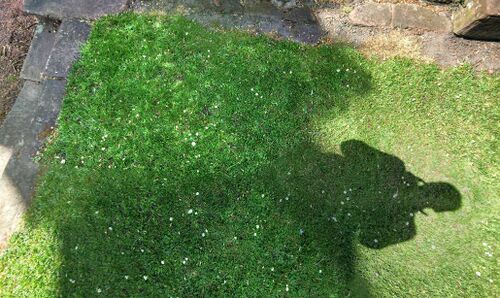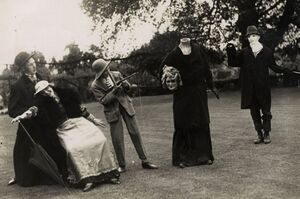Category:Ghost
Haunted places in Chester. To add a place to this list simply add this category to the page. See The Mystery Tour for a guide to "spooky" Chester. For more general folklore relating to the supernatural see the book "Traditions and Customs of Cheshire" by Christina Hole.
Haunted Chester
Chester claims to be the "most haunted city in England". One website listed 84 ghosts. York apparently has 504, so Chester appears to have a way to go as regards apparitions. In folklore, a ghost is the soul or spirit of a dead person or animal that can appear to the living. In "ghostlore", descriptions of ghosts vary widely from an invisible presence to translucent or barely visible wispy shapes, to realistic, lifelike forms. While ghosts are a "cultural universal" there is no scientific evidence for the existence of ghosts although various theories have been put forward as to why myths and legends of ghostly phenonmena persist. These range from optical illusions, ball lightning and geomagnetic phenomena, to walking dreams and many others.

One popular scientific explanation is pareidolia: the tendency for incorrect perception of a stimulus as an object, pattern or meaning known to the observer, such as seeing shapes in clouds, seeing faces in inanimate objects or abstract patterns, or hearing hidden messages in music (i.e. when played backwatds). Pareidolia was at one time considered a symptom of human psychosis, but it is now seen as a normal human tendency. The human brain is hard-wired to detect figures and faces as a way of detecting potential threats as well as promoting social interaction, and evolutionary pressures tend to make this system "fail" on the side of safety: it is better to mistake a bush for a tiger than a tiger for a bush.

"Ghost stories" are possibly also more likely to be recalled than other folklore. At Duddon, near Hockenhull Platts on the Gowy once stood the "Headless Woman", a pub now gone. There are at least two different local legends about this. In the first the woman was called Dorothy and accidentally decapitated by her father while he was trying to save her from the Roundheads. In the other the woman is called Grace, and, during the Civil War, when the Parliamentarians were getting close, the Hockenhulls (a Royalist family) left Grace the maid in charge of their house (possibly on the site of Hockenhull Hall) and treasure. Despite torture, she refused to say where it was hidden and had her head taken off as a result: i.e. they chopped the head off the only person who could tell them where the treasure was. Of course, her ghost wanders round with her head in her hands, haunting the area to this very day. One local story is that Washington Irving stopped here while travelling by coach from Birminham to Chester and was intrigued as to why the village inn was called "The Headless Woman". Against the landlord’s advice, Irving insisted on staying the night at the inn and had a bed made up in the "haunted" attic room. He kept a vigil all night, but did not see the headless woman. He did, however, claim to have heard a woman sobbing in the night and, in the morning, found "a patch of blood" on the floor of the attic. Prompted by his experience in Cheshire, Irving spent several months researching headless ghost tales. He found that that their incidence was ubiquitous throughout the British Isles, as a consequence he incorporated the story into "The Legend of Sleepy Hollow". So could this be true? - Irving certainly began writing the tales that would appear in "The Sketch Book" shortly after moving to England for the family business, in 1815, and is known to have visited both Birmingham and Chester. One point to note is that without the ghost story Dorothy (or Grace) might well, if she actually existed, be completely forgotten.
Other ghost stories are associated with drinking places around Chester and it might be surmised that the presence of alcohol is somehow connected with these apparitions. The "Black Dog", where the inquest into the "murder" of Charles Moston was held has a legend recorded on signage which purports to be the tale of a local spectral hound: the "Black Dog of Saighton" (or Waverton). In fact it is a folk-song written in about 1971 by the Marrowbones. The fact that it was a folk-song has been forgotten by many who assume that it is a real local legend. The "Black Dog" of the pub name was the emblem of Simon Ripley, abbot of St Werbugh (now Chester Cathedral) from 1265 until 1291 who had a house at Saighton and decoradted the gatehouse with his emblem, the black dog. The gatehouse survives as the entrance porch to "Saighton Grange" (now renamed as "Abbey Gate College" - some might not want to send their child to a school whose name sounds like "Satan Grange"). The head of a dog is carved into the base of the oriel window. Ripley's grave was found under the Cathedral Chapter House floor in 1723. Although this clearly bore the monogram "S.R". the skeleton wrapped in black leather was long thought to belong to Hugh Lupus because of the supposed "wolf's head" on the stone. This was of course the same "Black Dog" as is mentioned above. The "Ripley Stone" is on display in the cloister at the Chester Cathedral.
One of Chester's most famous ghosts is supposedly Harold Godwinson, who is reported to haunt the area around St Johns and the Hermitage. If you are ever alone there at night and encounter a mysterious figure dressed in robes, do try the Anglo-Saxon phrase: "ferþu hal, god cyning" ("go well, good king"). It might just be the local vicar, but it's good to be prepared.
Sources and links
Pages in category "Ghost"
The following 7 pages are in this category, out of 7 total.